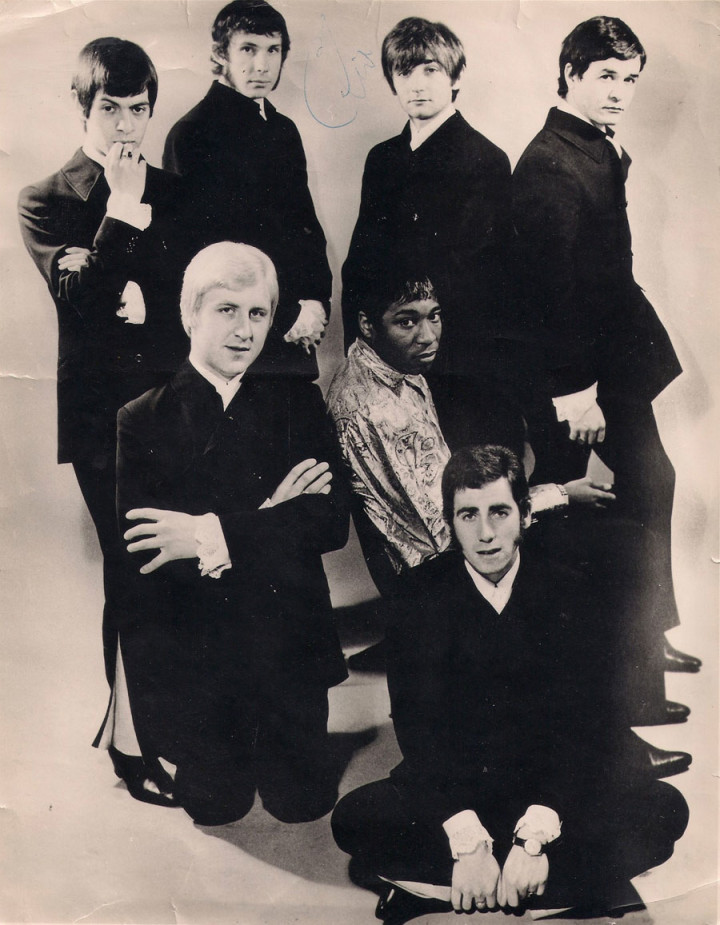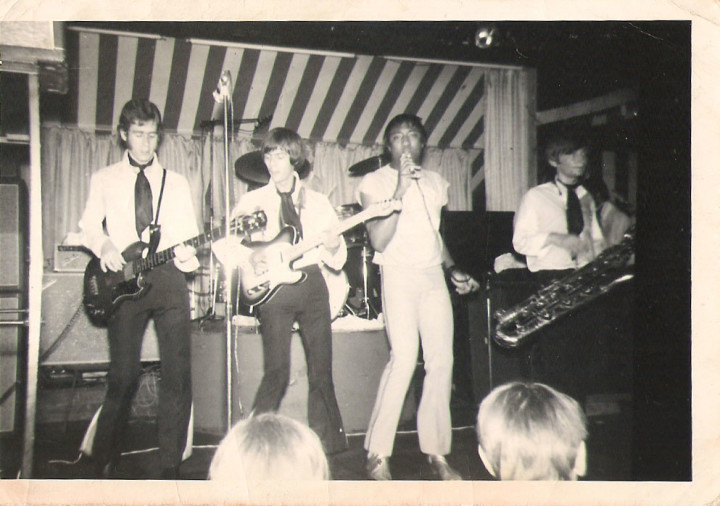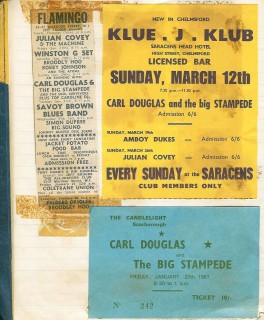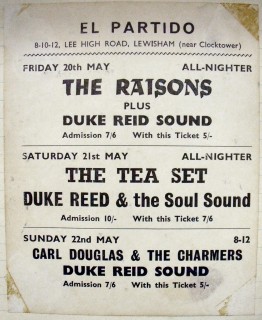
Geno Washington & The Ram Jam Band
(August 1968)
Geno Washington – lead vocals
Dave Greenslade – organ
Dave Tedstone – lead guitar, vocals
Peter Carney – bass, vocals
Lionel ‘Rocky’ Kingham – tenor saxophone
Buddy Beadle – baritone saxophone
Pat Higgs – trumpet
Colin Davey – drums
During May 1968 Geno Washington went to Madrid on his own and played at the Stones Club with Carl Douglas & The Big Stampede.
Back in the UK, during mid-August, he fired guitarist John Culley and trumpet player Pat Higgs while drummer Hans Herbert went into hospital for a hernia operation. Washington then put together a new formation around the surviving members.
Guitarist Dave Tedstone had a long pedigree, having worked with Herefordshire bands, Lee Starr & The Astrals and The Doc Thomas Group before joining Freddy Mack in London in April 1967. By early 1968, he was playing with Jimmy James & The Vagabonds with original Ram Jam members John Roberts and Herb Prestidge. Colin Davey had played drums with Tedstone in Freddy Mack’s band in 1967 and had also briefly played with Carl Douglas & The Big Stampede before that.
Original sax player Buddy Beadle returned after working with The Amboy Dukes, who’d shared the bill with The Ram Jam Band on numerous occasions.
The new line up recorded a three-hour BBC Radio 1 session at Maida Vale in late August. With Greenslade taking the lead as musical director, the group (with a session bass player) cut five tracks, including the old blues staple, “Rock Me Baby”, a cover of The Rolling Stones’ recent single “Jumpin’ Jack Flash” plus “Hi Heel Sneakers” and “Holdin’ On (With Both Hands)”, which were later picked up by collectors’ label Acid Jazz for a compilation EP.
Producer John Schroeder, however, was not happy with the new direction and with a live album lined up for August the new line up proved to be short-lived. Gigs were few and far between and while all of this was going on, Dave Greenslade began rehearsing with his new band, Colosseum.
Selected gigs (NME lists the following as the ones that Dave Tedstone line-up played):
10 August 1968 – Brighton Festival, Brighton, West Sussex
12 August 1968 – Portsmouth Guildhall, Portsmouth, Hants
15 August 1968 – Locarno, Bristol, Avon
16 August 1968 – Torquay Town Hall, Torquay, Devon with The Emotions
17 August 1968 – Winter Gardens, Weston-Super-Mare, Somerset

23-24 August 1968 – Scene Two Discotheque, Scarborough, North Yorkshire
27 August 1968 – Royal Lido Ballroom, Prestatyn, Wales with The Informers (this is missing from NME list above so may be another month)

30 August 1968 – Hemel Hempstead Pavilion, Hemel Hempstead, Hertfordshire with Toast (this may have been done by next line up)
Geno Washington & The Ram Jam Band
(August 1968-September 1968)
Geno Washington – lead vocals
John ‘Silkie’ Culley – lead guitar
Dave Greenslade – organ
Peter Carney – bass, vocals
Lionel ‘Rocky’ Kingham – tenor saxophone
Buddy Beadle – baritone saxophone
Hans Herbert – drums
In the last week of August, Dave Tedstone left to re-join Jimmy James & The Vagabonds. He later contributed recording sessions for Cartoone’s second album and then joined Tom Jones’s band, The Squires. In 1970, Tedstone joined Herbie Goins & The Night-Timers, reuniting with Buddy Beadle. The group cut an unreleased album at Trident Studios. John Culley resumed the guitar spot.
Colin Davey also departed at this point to join Chris Farlowe & The Thunderbirds and Hans Herbert returned. However, Buddy Beadle remained; Pat Higgs did not return.
The revised line up cut a lone single, “Bring It To Me Baby” c/w “I Can’t Let You Go” (Pye 7N 17649), which was released in November 1968.
Selected gigs:
31 August 1968 – Leas Cliffe Hall, Folkestone, Kent
1 September 1968 – Bank Holiday Bluesology Festival, Chateau Impney, Droitwich Spa, Worcestershire with The Move, Fleetwood Mac, Freddie Mack, Chris Farlowe, Wynder K Frogg, Family and John Mayall’s Bluesbreakers
1 September 1968 – Winter Gardens, Malvern, Worcestershire
1 September 1968 – Sherwood Rooms, Nottingham
2 September 1968 – Golden Torch, Tunstall, Staffordshire
7 September 1968 – Winter Gardens, Malvern, Worcestershire with The Soul Difference
Geno Washington & The Ram Jam Band
(September 1968-December 1968)
Geno Washington – lead vocals
John ‘Silkie’ Culley – lead guitar
Keith O’Connell – organ
Peter Carney – bass, vocals
Buddy Beadle – baritone saxophone
Steve Gregory – tenor saxophone
Rod Baby – trumpet
Hans Herbert – drums
In early September, Dave Greenslade formally departed to play with his new band, Colosseum. Longstanding member Lionel Kingham also departed and later worked with Jimmy James & The Vagabonds before doing sessions for Henry McCullough and Geoff Muldaur among others.
With Greenslade gone, the band recruited Manchester musician, Keith O’Connell, who’d played with local groups The Raging Storms and Glass Menagerie.
Beadle recommended his former band mate from The Amboy Dukes, Steve Gregory, who’d played with The Alan Price Set before that. The band also added trumpet player Rod Baby.
Selected gigs:
13 September 1968 – Mayfair, Newcastle upon Tyne, Tyne & Wear with The Idle Race

14 September 1968 – Imperial Ballroom, Nelson, Lancashire

27 September 1968 – Church Elm, Discotheque, Dagenham, London with supporting group (confirmed by Jim Smith)
27 September 1968 – Falkirk Town Hall, Falkirk, Scotland with The Brian Marshall Foundation and Absolute (Herbert recalls that Geno got laryngitis during one of the Scottish tours and he had to cover lead vocals from the drum kit. This date was probably 28 September)

28 September 1968 – Ayr Ice Rink, Ayr, Scotland with Vanity Fayre and supporting groups
29 September 1968 – Kinema Ballroom, Dunfermline, Scotland with The Shadettes (also played Maryland Ballroom, Glasgow around this time)
30 September 1968 – The Beach, Aberdeen, Scotland
4 October 1968 – Top Rank, Leicester
7 October 1968 – Rhodes Centre, Bishop’s Stortford, Hertfordshire
11 October 1968 – Salford University, Salford, Greater Manchester
12 October 1968 – California Ballroom, Dunstable, Bedfordshire
15 October 1968 – Top Rank, High Wycombe, Bucks
17 October 1968 – RAF Hollyhead, Anglesey
18 October 1968 – Bridge Place Country Club, Bridge near Canterbury, Kent
19 October 1968 – The College, Chester, Cheshire
21 October 1968 – Top Rank, Sheffield, South Yorkshire
Mid-October 1968 – HM Wormswood Scrubs, London
October-November 1968 – Piper Club, Rome, Italy (also gigs in Turin)
2 November 1968 – The Swan, Yardley, West Midlands with Jigsaw
2 November 1968 – George Ballroom, Hinckley, Leicestershire
15 November 1968 – Romanos, Belfast, Northern Ireland with The Sands
16 November 1968 – New Arcadia, Bray, Republic of Ireland with The Trixons
22 November 1968 – Leicester College of Education, Leicester

23 November 1968 – Chelmsford Corn Exchange, Chelmsford, Essex with Apricot Brande
25 November 1968 –Top Rank, Cardiff, Wales
28 November 1968 – Top Rank, Sunderland, Tyne & Wear
6 December 1968 – Locarno Ballroom, Sunderland, Tyne & Wear

12 December 1968 – Mayfair Ballroom, Newcastle upon Tyne, Tyne & Wear with Jimmy Powell & The Dimensions, Mr Poobah’s Chicago Line, Georgia Quintet
20-21 December 1968 – Scene Two, Scarborough, North Yorkshire
22 December 1968 – Top Rank Suite, Birmingham, West Midlands
24 December 1968 – Cliffs Pavilion, Southend-on-Sea, Essex with Ruby James & The Trifle and The Purple Dream
Geno Washington & The Ram Jam Band
(December 1968-April 1969)
Geno Washington – lead vocals
John ‘Silkie’ Culley – lead guitar
Keith O’Connell – organ
Peter Carney – bass, vocals
Buddy Beadle – baritone saxophone
Steve Gregory – tenor saxophone
Rod Baby – trumpet
Malcolm Wolffe – drums
Hans Herbert did not stay long on his return. After leaving Geno Washington he worked with country-rock bands Jamie’s People and Lincoln Park Inn among others.
Malcolm Wolffe, who’d previously played with The Tribe and then Happy Magazine took his place.
Selected gigs:
4 January 1969 – Whitchurch Town Hall, Whitchurch, Wales with Shady Lane and The Antrix (Saturday)
17 January 1969 – Central Pier, Morecombe, Lancashire
18 January 1969 – Imperial Ballroom, Nelson, Lancashire
20 January 1969 – St Matthew’s Hall, Ipswich
25 January 1969 – Bradford University, Bradford, West Yorkshire
25 January 1969 – Gaeity Ballroom, Ramsey, Cambridgeshire
26 January 1969 – Britannia Rowing Club, Nottingham
29 January 1969 – Oldham College of Further Education, Oldham, Lancashire
30 January 1969 – Riverton Barn, Bolton, Lancashire
31 January 1969 – Locarno Ballroom, Sunderland, Tyne and Wear with Cupid’s Inspiration
2-10 February 1969 – Showboat Variety Club, Middlesbrough
12 February 1969 – Top Rank Ballroom, Cardiff, Wales
13 February 1969 – Locarno Ballroom, Coventry, West Midlands
15 February 1969 – Winter Gardens, Weston-Super-Mare, Somerset
23 February 1969 – Kinema Ballroom, Dunfermline, Scotland with Alan Jordan & The KB Showband
3 March 1969 – Ice Rink, Liverpool
5 March 1969 – Winter Gardens, Morecombe, Lancashire
7 March 1969 – College Ballroom, Hinckley, Leicestershire
8 March 1969 – Music Hall, Shrewsbury, Shropshire
12 March 1969 – Skyline Ballroom, Hull, Humberside
14 March 1969 – Public Baths, Sutton-in-Ashfield, Nottinghamshire
15 March 1969 – Leeds University, Leeds, West Yorkshire
16 March 1969 – Pop World ’69, Empire Pool, Wembley, Middlesex with Fleetwood Mac, Amen Corner, The Move, The Gun, Barry Ryan and others

21 March 1969 – Silver Blades, Streatham, southwest London
23 March 1969 – Railway Hotel, Wealdstone, London
5 April 1969 – Kinema Ballroom, Dunfermline, Scotland with Alan Jordan & The KB Showband and The Shadettes

7 April 1969 – Belfry, Wishaw, West Midlands with Revolver

18 April 1969 – Kinema Ballroom, Stranraer, Scotland with Systems Go Most likely date for John Culley’s final gig
Geno Washington & The Ram Jam Band
(April 1969-September 1969)
Geno Washington – lead vocals
Keith Field – lead guitar, vocals
Keith O’Connell – organ
Peter Carney – bass, vocals
Buddy Beadle – baritone saxophone
Steve Gregory – tenor saxophone
Malcolm Wolffe – drums
John Culley departed after a Scottish tour in March-April 1969, playing his final gig in Stranraer (see above). After working in the Ivory Coast with The Crazy Fingers, he joined Cressida in 1970 and later played with Black Widow. Rod Baby departed at the same time.
Guitarist Keith Field, formerly with The Blue Aces, and, more significantly, Ferris Wheel, took over from John Culley after cutting a solo single, “The Day That War Broke Out” c/w “Stop! Thief” for Polydor in September 1968.
The new line up recorded a lone single, “My Little Chickadee” c/w “Seven Eleven” (Pye 7N 17745), which was released in June 1969.
Selected gigs:
April 1969 – Gigs in Netherlands (according to Billboard)
25 April 1969 – White Lion, Edgware, London
26 April 1969 – Winning Post Hotel, Twickenham, London
20 May 1969 – Bradford University, Bradford, West Yorkshire with The Idle Race, The Honeybus, Clouds and others
23 May 1969 – Royal Agricultural College, Cirencester
24 May 1969 – The Pavilion, Buxton, Derbyshire
26 May 1969 – Skegness Seaside Soul Festival, Skegness, Lincolnshire with Amen Corner, Inez & Charlie Foxx, The Fantastics and Jimmy James & The Vagabonds
30 May 1969 – Newmarket Discotheque, Bridgwater, Somerset
31 May 1969 – California Ballroom, Dunstable, Bedfordshire with Tract and Virgin Hearse
June 1969 – Scottish tour (includes gigs with Jo Jo Gunne and Three Dog Night)
13 June 1969 – St Albans City Hall, St Albans, Hertfordshire with The Sweet and Pedestrian Crossing
6 July 1969 – Citation Hotel, Perth, Scotland
6 July 1969 – Grand Hall, Kilmarnock, Scotland
8 July 1969 – 400 Ballroom, Torquay, Devon
11 July 1969 – Ritz, Bournemouth, Dorset
13 July 1969 – Hastings Pier, Hastings, East Sussex with Canterbury Tales
19 July 1969 – Civic Hall, Guildford, Surrey with supporting acts
19 July 1969 – Mayfair Ballroom, Newcastle upon Tyne, Tyne & Wear (unlikely if Guildford date took place unless one is incorrect)
21 July 1969 – Quaintways, Chester, Cheshire with Roundabout with Wild Duncan and Syrian Blue
27 July 1969 – Start week at Fiesta, Stockton
August 1969 – Short tour of Northern Ireland and Republic of Ireland (around now)
5 August 1969 – 400 Ballroom, Torquay, Devon
9 August 1969 – Three-day Swedish tour starts (advertised in music press)
29 August 1969 – Hemel Hempstead Pavilion, Hemel Hempstead, Hertfordshire with The Zoo
1 September 1969 – Pop and Blues Festival, Pennycross Sports Stadium, Plymouth, Devon with Fleetwood Mac, The Move, Dave Amboy, Rod Mason Jass Band and The Nashville Teens
12 September 1969 – Rex Hotel, Whitley Bay with supporting group
20 September 1969 – Belfry, Wishaw, West Midlands with Shy Limbs
The Coventry Evening Telegraph’s 29 September issue notes that Geno Washington has split from the group. The band were due to appear at Chesford Grange, Kenilworth tonight and were replaced by The Drifters.
Geno Washington & The Ram Jam Band
(October 1969-November 1970)
Geno Washington – lead vocals
Alan Griffin – lead guitar, vocals
Tom Duffy – bass, vocals
Winston ???? – keyboards
Tony Hall – tenor saxophone
Brent Scott Carter – tenor saxophone
Frank Charlton – trumpet
Larry ???? – drums
The Ram Jam Band split with Washington after working at the Neago Club in Majorca in October 1969.
Beadle and Gregory would go on to play a multitude of sessions with artists as diverse as Ginger Baker’s Airforce, Babe Ruth, Bell & Arc, Chicken Shack, Andy Fairweather-Low, Alan Hull, Otis Spann, Suzi Quatro, Freddie King and Lindisfarne. They also became members of Gonzalez and recorded a string of albums in the 1970s.
NME announced in the week ending 4 October 1969 that Geno Washington had split from The Ram Jam Band and returned to The United States. Fabulous 208 magazine mentioned in its 25 October issue that the group had split in the same week as Amen Corner and The Marbles.
The singer duly returned from the United States this month and put together an entirely new version of The Ram Jam Band.
Tom Duffy came from Newcastle and had previously played with The Sect. The group’s new drummer was another American, from California. Alan Griffin had previously played with Croydon, south London band, The Subjects.
Londoners Tony Hall and Brent Scott Carter both came in from Simon K & The Meantimers. Tony Hall had a long pedigree having previously worked with West London outfits, Peter Nelson & The Travellers, Peter’s Faces, Wainwright’s Gentlemen, The Flowerpot Men and Rupert’s Spoon.
Selected gigs:

1 November 1969 – Belfry, Wishaw, West Midlands with BZN and Heaven
29 November 1969 – Imperial Ballroom, Nelson, Lancashire

21 December 1969 – Top Rank Suite, Birmingham

24 December 1969 – Dreamland Ballroom, Margate, Kent with The Candy Choir
29 January 1970 – Crescendo Club, Rex Hotel, Whitley Bay

5 February 1970 – Rebecca’s, Birmingham with Sonic Invaders
6 March 1970 – Carousel, Belfast, Northern Ireland with Derrick & Sounds

28 March 1970 – Belfry, Wishaw, West Midlands
4 April 1970 – Marquee, Wardour Street, Soho, central London
1 May 1970 – Flamingo, Ballymena, Northern Ireland
2 May 1970 – Romanos, Belfast, Northern Ireland
24 July 1970 – Pavilion Ballroom, Bournemouth, Dorset with Tension
14 August 1970 – 400 Ballroom, Torquay, Devon
2 October 1970 – Fresher’s Ball, Liverpool Polytechnic Guild of Students, Liverpool with Stack Waddy
8 November 1970 – Up the Junction, Crewe, Cheshire
13 November 1970 – Ballerina Ballroom, Nairn, Scotland
14 December 1970 – Wall City, Chester, Cheshire with Satisfaction with Mike Cotton, Wall City Jazzmen
Around December 1970, Tom Duffy left and went on to record with Arc and Bell & Arc before playing and recording with Lindisfarne. Frank Charlton also left and later recorded with The Avant Gardeners.
Roger Flavell joined on bass after working with Grand Union (Bandwagon’s backing band) and Judd. Further personnel changes took place in early 1971 before the musicians broke away from Geno Washington.
Flavell subsequently played with The Tommy Hunt Band and recorded with The Byron Band among others. Brent Scott Carter later appeared on an album by Babe Ruth while Tony Hall did sessions for Dana Gillespie among others.
Selected gigs:
26 December 1970 – Marquee, Wardour Street, Soho, London
Sources include: Melody Maker, NME, Newcastle Evening Chronicle, Nottingham Evening Post, Fabulous 208, Kent Herald, Wrexham Leader, Berkhamsted Gazette, Birmingham Evening Mail, Southend Standard, Time Out, New Ross Standard, Wicklow People, Aberdeen Evening Express, Belfast Telegraph, Walsall Observer and South Staffordshire Chronicle, Newcastle Evening Chronicle, Wells Journal, Liverpool Echo, Torbay Express and South Devon Echo, Cheshire Observer, Wigtownshire Free Press & Galloway Advertiser.
Huge thanks to Peter Carney, John Culley, Dave Tedstone and Tony Hall for helping with line ups.
www.rockpopmem.com
www.california-ballroom.info/gigs/
http://www.lankybeat.com/The%20Impnelson.html
http://www.readysteadygone.co.uk/
http://www.kinemagigz.com/1969.htm
Copyright © Nick Warburton. All Rights Reserved. No part of this article may be reproduced or transmitted in any from or by any means, without prior permission from the author. To contact the author, email: Warchive@aol.com

















































































































































